Bonding Characteristics of CLT Made from Silver Birch (Betula pendula Roth.), European Aspen (Populus tremula L.) and Norway Spruce (Picea abies (L.) H. Karst.) Wood
Abstract
:1. Introduction
2. Materials and Methods
2.1. CLT Preparation
2.2. Methods
2.2.1. Delamination
- The total delamination (Delamtot) length does not surpass 10% of the sum of both glue lines;
- The maximum delamination (Delammax) length of each sample does not exceed 40% of the overall length of the single glue line.
- The minimum wood failure (WFmin) percentage of each split glued area must be at least 50%;
- The minimum wood failure (WFtot) percentage of the sum of all split glued areas must be at least 70%.
2.2.2. Bond Shear Strength
3. Results and Discussion
3.1. Delamination and Wood Failure
3.2. Bond Shear Strength
4. Conclusions
- The minimum criteria for maximum and total delamination (Delamtot ≤ 10%, Delammax ≤ 40%), as defined by EN 16351 [11], were variably met. 70% of spruce CLTs passed the delamination test (80% meeting the Delamtot requirements and 95% meeting the Delammax requirements). However, aspen CLTs only met the minimum delamination criteria in 60% of cases (60% meeting both the Delamtot and Delammax requirements), while only 45% of birch CLTs passed the delamination test (65% meeting the Delamtot requirements and 80% meeting the Delammax requirements).
- Although aspen and birch CLTs did not meet the minimum delamination requirements, they met the minimum requirement of 70% wood failure percentage (WFP). Spruce CLT reached the highest average WFP.
- The aspen and birch CLTs met the minimum criterion for bond shear strength of 1 N/mm2 set by EN 16351 [11]. The bond shear strength values were 73.7% (aspen) and 105.3% (birch) higher than for the spruce CLT.
- In general, it can be stated that hardwoods such as aspen and birch can be used for CLT. However, it is recommended for less demanding conditions of use in terms of humidity fluctuations, or it is necessary to use a modified adhesive for hardwood that ensures higher resistance to delamination.
Author Contributions
Funding
Data Availability Statement
Conflicts of Interest
References
- Bao, Y.; Lu, W.; Yue, K.; Zhou, H.; Lu, B.; Chen, Z. Structural performance of cross-laminated timber-concrete composite floors with inclined self-tapping screws bearing unidirectional tension-shear loads. J. Build. Eng. 2022, 55, 104653. [Google Scholar] [CrossRef]
- Yusoh, A.S.; Tahir, P.M.; Uyup, M.K.A.; Lee, S.H.; Husain, H.; Khaidzir, M.O. Effect of wood species, clamping pressure and glue spread rate on the bonding properties of cross-laminated timber (CLT) manufactured from tropical hardwoods. Constr. Build. Mater. 2021, 273, 121721. [Google Scholar] [CrossRef]
- Li, M.; Zhang, S.; Gong, Y.; Tian, Z.; Ren, H. Gluing techniques on bond performance and mechanical properties of cross-laminated timber (CLT) made from Larix kaempferi. Polymers 2021, 13, 733. [Google Scholar] [CrossRef]
- Das, S.; Gašparík, M.; Sethy, A.K.; Kytka, T.; Kamboj, G.; Rezaei, F. Bonding performance of mixed species cross laminated timber from poplar (Populus nigra L.) and maple (Acer platanoides L.) glued with melamine and PUR adhesive. J. Build. Eng. 2023, 68, 106159. [Google Scholar] [CrossRef]
- Brunetti, M.; Nocetti, M.; Pizzo, B.; Negro, F.; Aminti, G.; Burato, P.; Cremonini, C.; Zanuttini, R. Comparison of different bonding parameters in the production of beech and combined beech-spruce CLT by standard and optimized tests methods. Constr. Build. Mater. 2020, 265, 120168. [Google Scholar] [CrossRef]
- Aicher, S.; Hirsch, M.; Christian, Z. Hybrid cross-laminated timber plates with beech wood cross-layers. Constr. Build. Mater. 2016, 124, 1007–1018. [Google Scholar] [CrossRef]
- Crovella, P.; Smith, W.; Bartczak, J. Experimental verification of shear analogy approach to predict bending stiffness for softwood and hardwood cross-laminated timber panels. Constr. Build. Mater. 2019, 229, 116895. [Google Scholar] [CrossRef]
- Sciomenta, M.; Spera, L.; Bedon, C.; Rinald, V.; Fragiacomo, M.; Romagnoli, M. Mechanical characterization of novel homogeneous beech and hybrid beech-Corsican pine thin cross-laminated timber panels. Constr. Build. Mater. 2021, 271, 121589. [Google Scholar] [CrossRef]
- Espinoza, O.; Buehlmann, U. Cross-laminated timber in the USA: Opportunity for hardwoods? Curr. For. Rep. 2018, 4, 1–12. [Google Scholar] [CrossRef]
- Dugmore, M.; Nocetti, M.; Brunetti, M.; Naghizadeh, Z.; Wessels, C.B. Bonding quality of cross-laminated timber: Evaluation of test methods on Eucalyptus grandis panels. Constr. Build. Mater. 2019, 211, 217–227. [Google Scholar] [CrossRef]
- EN 16351; Timber Structures—Cross Laminated Timber—Requirements. European Committee for Standardization (CEN): Brussels, Belgium, 2015.
- Hu, W.; Zhang, J. Bolt-bearing yield strength of three-layered cross-laminated timber treated with phenol formaldehyde resin. Forests 2020, 11, 551. [Google Scholar] [CrossRef]
- Brandner, R.; Flatscher, G.; Ringhofer, A.; Schickhofer, G.; Thiel, A. Cross laminated timber (CLT): Overview and development. Eur. J. Wood Wood Prod. 2016, 74, 331–351. [Google Scholar] [CrossRef]
- Musah, M.; Wang, X.; Dickinson, Y.; Ross, R.J.; Rudnicki, M.; Xie, X. Durability of the adhesive bond in cross-laminated northern hardwoods and softwoods. Constr. Build. Mater. 2021, 307, 124267. [Google Scholar] [CrossRef]
- Purba, C.Y.C.; Pot, G.; Collet, R.; Chaplain, M.; Coureau, J.L. Assessment of bonding durability of CLT and glulam made from oak and mixed poplar-oak according to bonding pressure and glue type. Constr. Build. Mater. 2022, 335, 127345. [Google Scholar] [CrossRef]
- EN 14081-1+A1; Timber Structures—Strength Graded Structural Timber with Rectangular cross Section—Part 1: General Requirements. European Committee for Standardization: Brussels, Belgium, 2016.
- FprEN 14732; Timber Structures—Prefabricated Wall, Floor and Roof Elements—Requirements. European Committee for Standardization: Brussels, Belgium, 2014.
- Morin-Bernard, A.; Blanchet, P.; Dagenais, C.; Achim, A. Use of northern hardwoods in glued-laminated timber: A study of bondline shear strength and resistance to moisture. Eur. J. Wood Wood Prod. 2020, 78, 891–903. [Google Scholar] [CrossRef]
- Betti, M.; Brunetti, M.; Lauriola, M.P.; Nocetti, M.; Ravalli, F.; Pizzo, B. Comparison of newly proposed test methods to evaluate the bonding quality of Cross-Laminated Timber (CLT) panels by means of experimental data and finite element (FE) analysis. Constr. Build. Mater. 2016, 125, 952–963. [Google Scholar] [CrossRef]
- Knorz, M.; Torno, S.; van de Kuilen, J.W. Bonding quality of industrially produced cross-laminated timber (CLT) as determined in delamination tests. Constr. Build. Mater. 2017, 133, 219–225. [Google Scholar] [CrossRef]
- Sikora, K.S.; McPolin, D.O.; Harte, A.M. Shear strength and durability testing of adhesive bonds in cross-laminated timber. J. Adhes. 2016, 92, 758–777. [Google Scholar] [CrossRef]
- Weidman, A. Optimizing Bonding Conditions for cross Laminated Timber (CLT) Panels Using Low Density Hybrid Poplar. Bachelor’s Thesis, University Honors College, Oregon State University, Corvallis, OR, USA, 2015. [Google Scholar]
- Ammann, S.; Niemz, P. Mixed-mode fracture toughness of bond lines of PRF and PUR adhesives in European beech wood. Holzforschung 2015, 69, 415–420. [Google Scholar] [CrossRef]
- Shirmohammadli, Y.; Pizzi, A.; Raftery, G.M.; Hashemi, A. One-component polyurethane adhesives in timber engineering applications: A review. Int. J. Adhes. Adhes. 2023, 123, 103358. [Google Scholar] [CrossRef]
- Haas, P.; Wittel, F.K.; Mendoza, M.; Hermann, H.J.; Niemz, P. Adhesive penetration in beech wood: Experiments. Wood Sci. Technol. 2012, 46, 243–256. [Google Scholar] [CrossRef]
- Luedke, J.; Amen, C.; van Ofen, A.; Lehringer, C. 1C-PUR-bonded hardwoods for engineered wood products: Influence of selected processing parameters. Eur. J. Wood Wood Prod. 2015, 73, 167–178. [Google Scholar] [CrossRef]
- Lima, C.K.P.; Mori, F.A.; Mendes, L.M.; Carneiro, A.D.C.O. Anatomic and chemical characteristics of Eucalyptus clones wood and its influence upon bonding. Cerne 2015, 13, 123–129. [Google Scholar]
- Jeitler, G.; Augustin, M. Ist Birke die bessere Buche? Mechanische Eigenschaften und Referenzprojekte aus BIRKE|BSH&BSP. In Proceedings of the 22nd Internationales Holzbau-Forum (IHF), Garmisch-Partenkirchen, Germany, 7–9 December 2016; pp. 211–226. (In German). [Google Scholar]
- Engelhardt, M.; Böger, T.; Gigl, M.; Meng, C.; Soprunyuk, V.; Schranz, W.; Richter, K.; Sánchez-Ferrer, A. Interactions of hydrophilic birch wood (Betula pendula Roth) extractives with adhesives for load-bearing timber structures. Int. J. Adhes. Adhes. 2023, 125, 103447. [Google Scholar] [CrossRef]
- Kramer, A.; Barbosa, A.R.; Sinha, A. Viability of hybrid poplar in ANSI approved cross-laminated timber applications. J. Mater. Civ. Eng. 2014, 26, 06014009. [Google Scholar] [CrossRef]
- Li, M.; Ren, H. Study on the interlaminar shear properties of hybrid cross-laminated timber (HCLT) prepared with larch, poplar and OSB. Ind. Crops Prod. 2022, 189, 115756. [Google Scholar] [CrossRef]
- Gong, M.; Tu, D.; Li, L.; Chui, Y.H. Planar shear properties of hardwood cross layer in hybrid cross laminated timber. In Proceedings of the 5th International Scientific Conference of Hardwood Processing (ISCHP), Québec City, QC, Canada, 15–17 September 2015. [Google Scholar]
- Oberhofnerová, E.; Pánek, M. Surface wetting of selected wood species by water during initial stages of weathering. Wood Res. 2016, 61, 545–552. [Google Scholar]
- Konnerth, J.; Kluge, M.; Schweizer, G.; Miljković, M.; Gindl-Altmutter, W. Survey of selected adhesive bonding properties of nine European softwood and hardwood species. Eur. J. Wood Wood Prod. 2016, 74, 809–819. [Google Scholar] [CrossRef]
- Lima García, J.; Pans, G.; Phanopoulos, C. Use of lignin in polyurethane-based structural wood adhesives. J. Adhes. 2018, 94, 814–828. [Google Scholar] [CrossRef]
- Kläusler, O.; Hass, P.; Amen, C.; Schlegel, S.; Niemz, P. Improvement of tensile shear strength and wood failure percentage of 1C PUR bonded wooden joints at wet stage by means of DMF priming. Eur. J. Wood Wood Prod. 2014, 72, 343–354. [Google Scholar] [CrossRef]
- Lu, Z.; Zhou, H.; Liao, Y.; Hu, C. Effects of surface treatment and adhesives on bond performance and mechanical properties of cross-laminated timber (CLT) made from small diameter Eucalyptus timber. Constr. Build. Mater. 2018, 161, 9–15. [Google Scholar] [CrossRef]
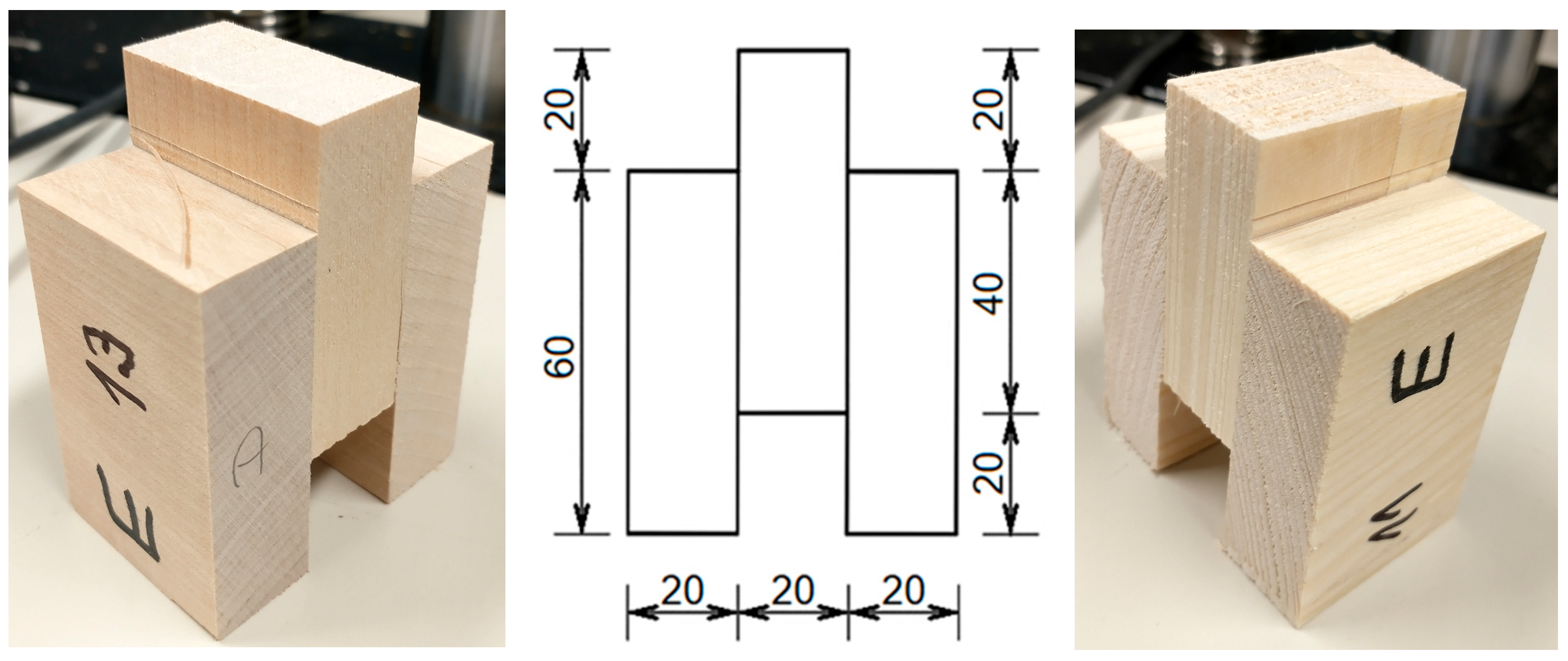
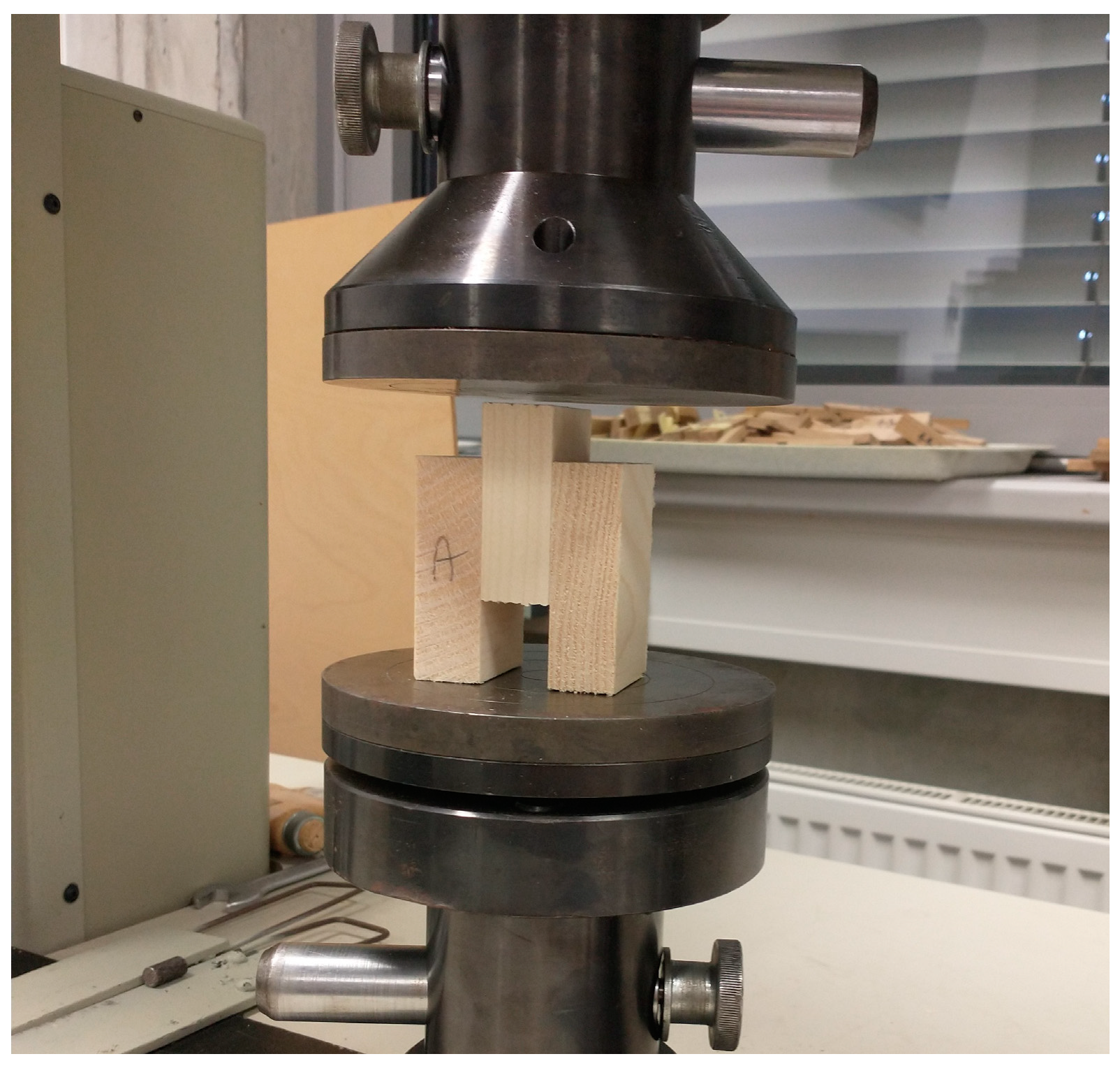
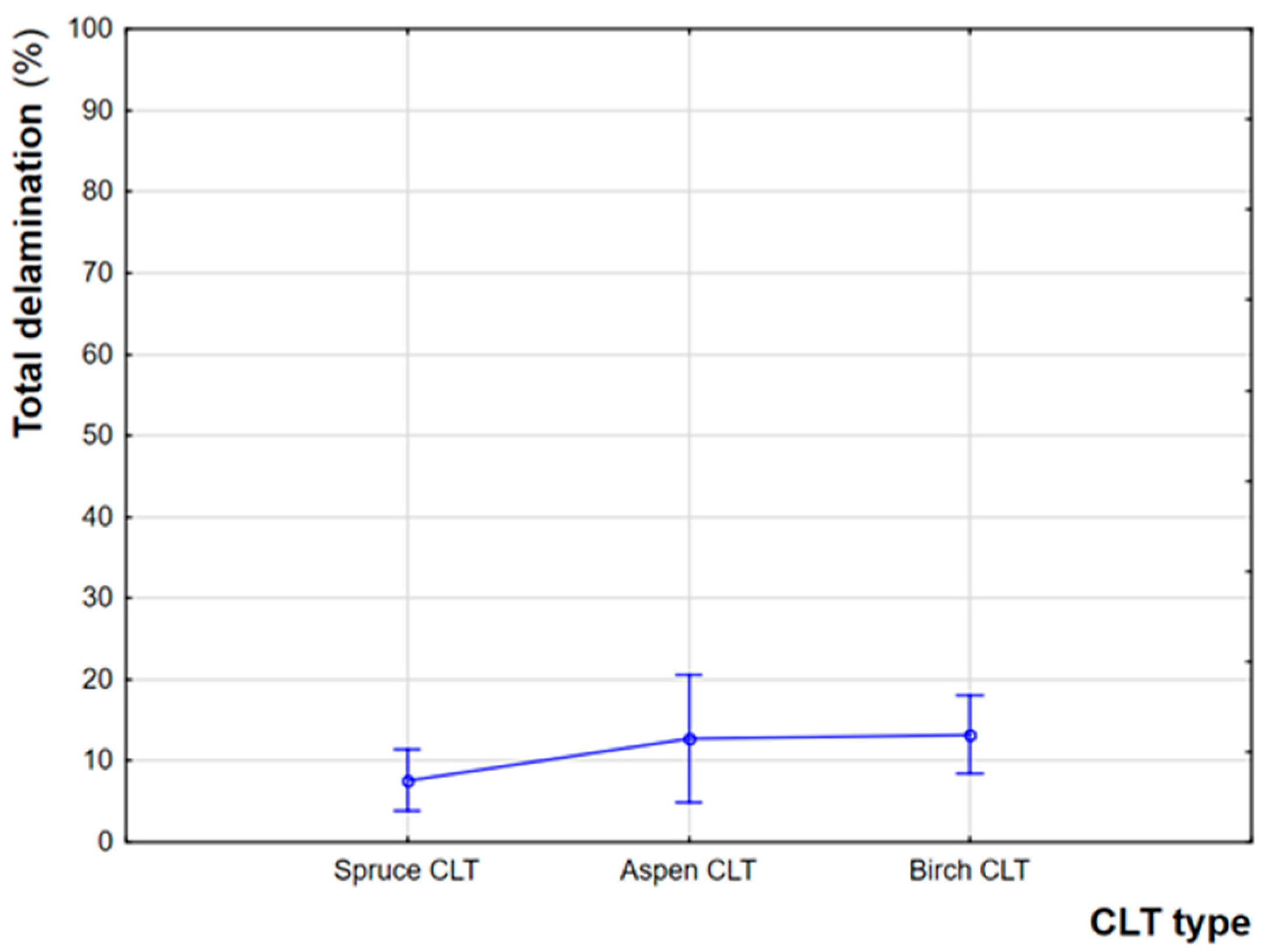
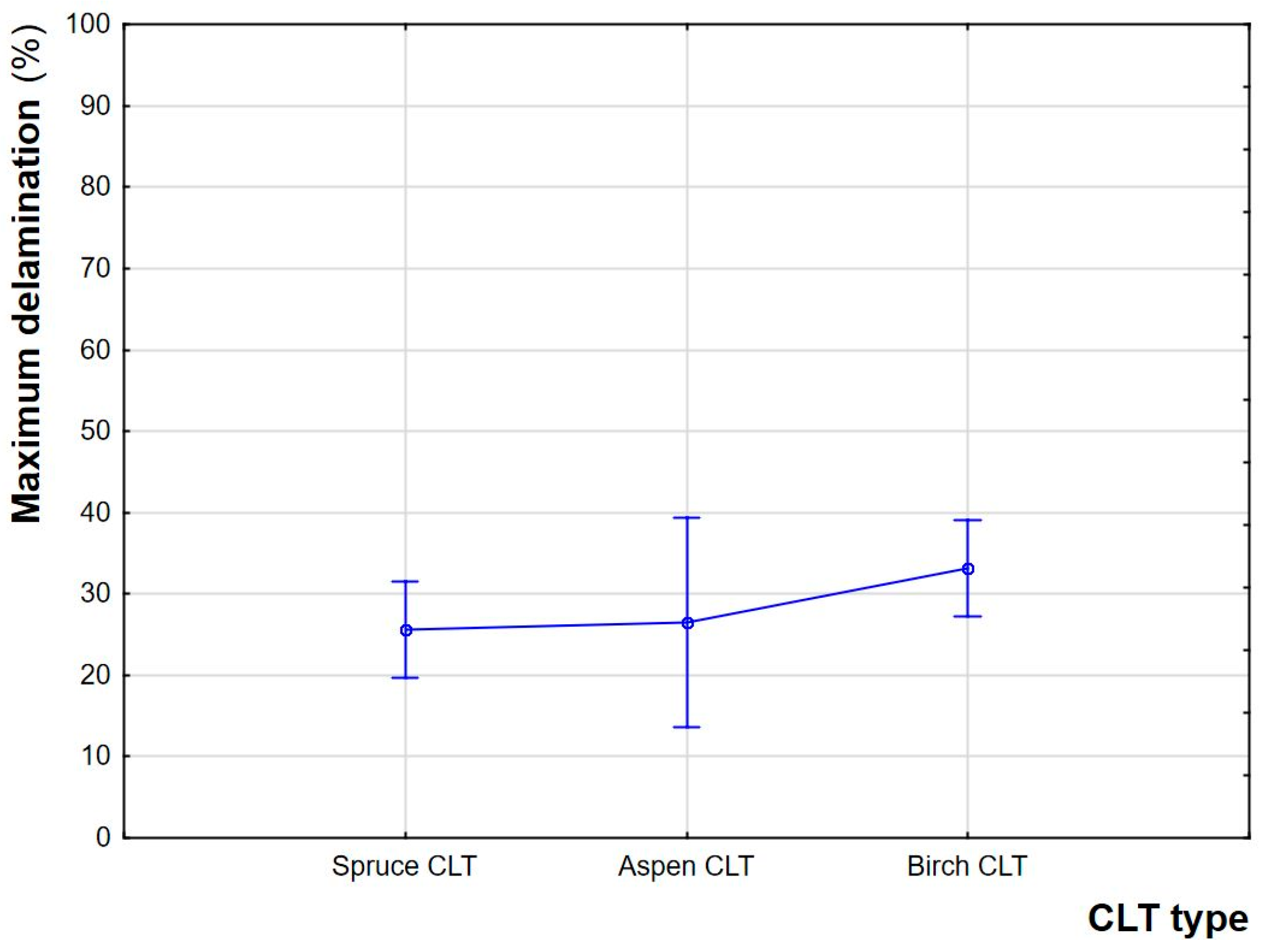
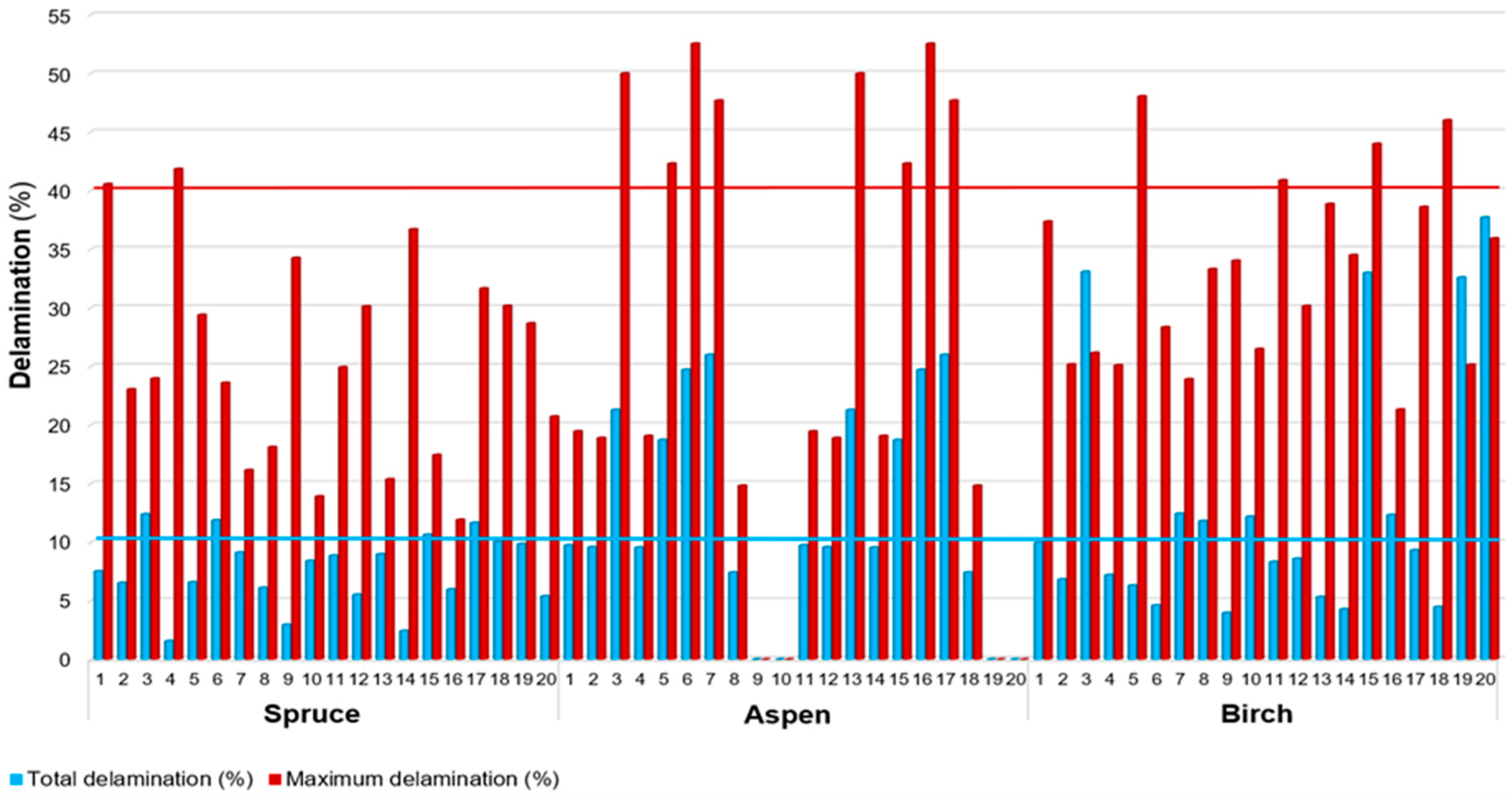

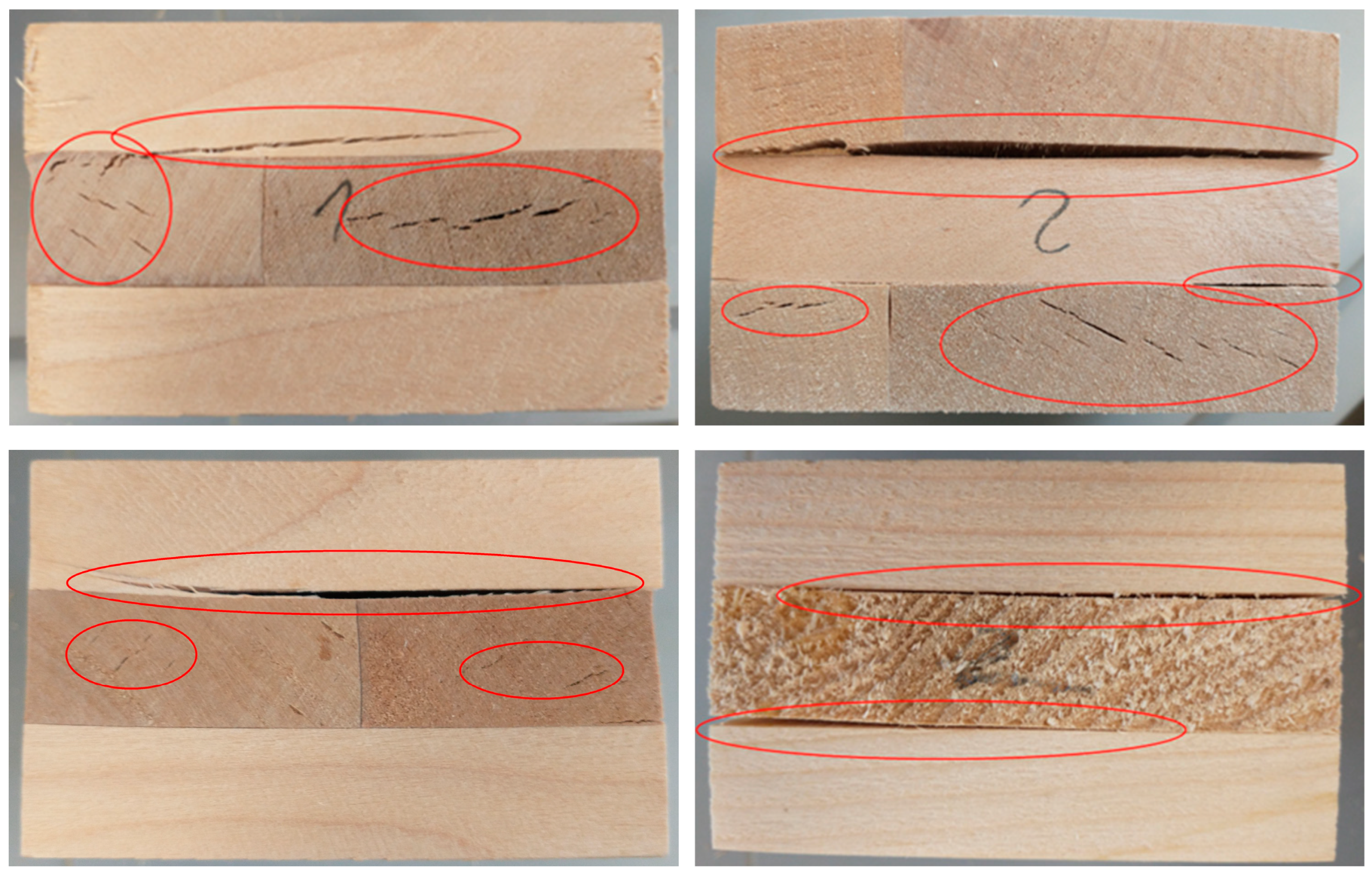
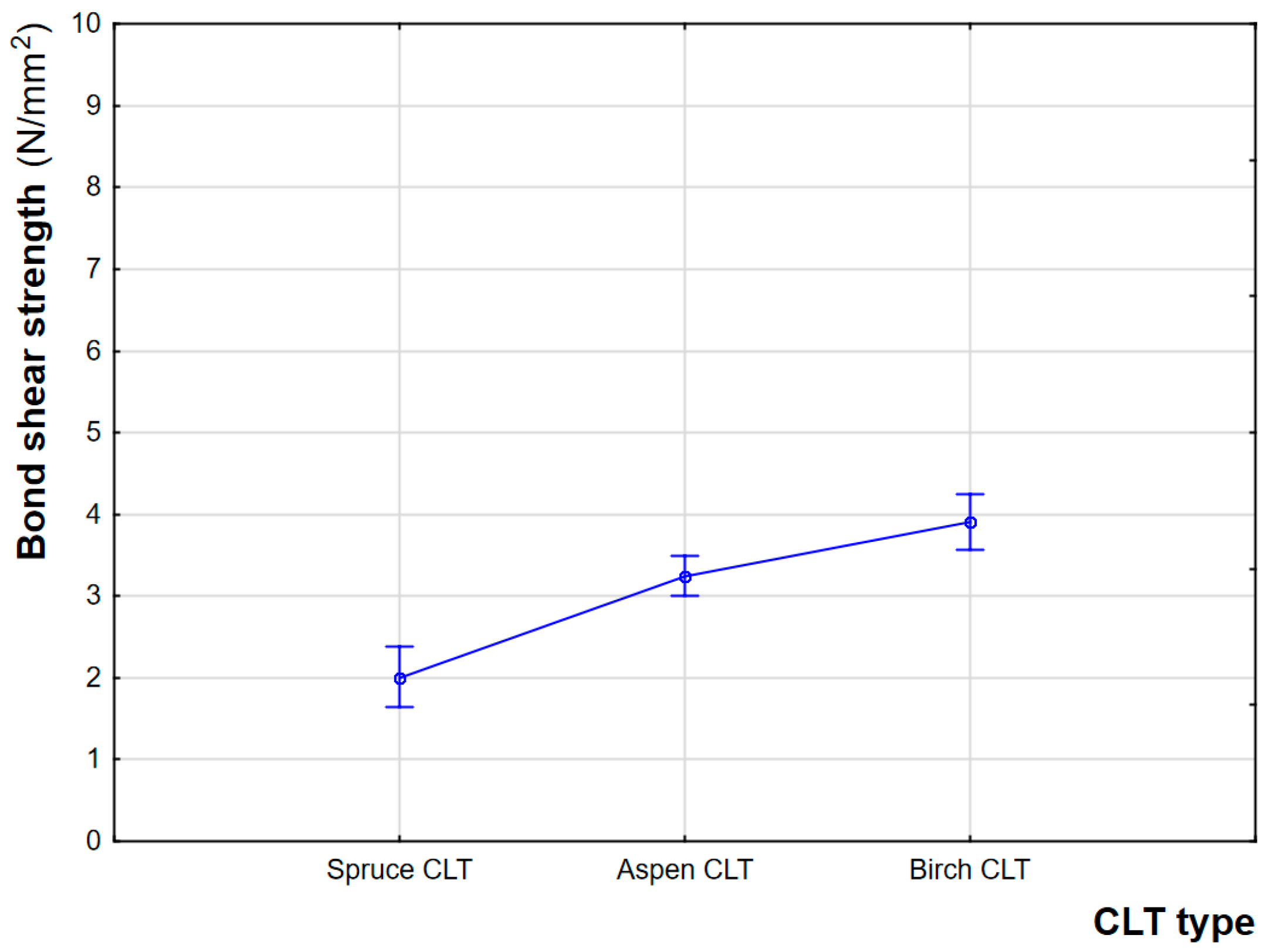

| Effect | Sum of Squares | Degree of Freedom | Variance | Fischer’ F-Test | p-Value |
|---|---|---|---|---|---|
| Intercept | 7487.57 | 1 | 7487.57 | 102.9893 | 0.000000 ** |
| Wood species | 382.8500 | 2 | 191.4250 | 2.6330 | 0.080590 NS |
| Error | 4144.0370 | 57 | 72.7020 |
| Effect | Sum of Squares | Degree of Freedom | Variance | Fischer’ F-Test | p-Value |
|---|---|---|---|---|---|
| Intercept | 48,474.13 | 1 | 48,474.13 | 278.2345 | 0.000000 ** |
| Wood species | 681.6400 | 2 | 340.8200 | 1.9563 | 0.150763 NS |
| Error | 9930.5600 | 57 | 174.2200 |
| Effect | Sum of Squares | Degree of Freedom | Variance | Fischer’ F-Test | p-Value |
|---|---|---|---|---|---|
| Intercept | 420,023.40 | 1 | 420,023.40 | 4727.8224 | 0.000000 ** |
| Wood species | 428.7648 | 2 | 214.3824 | 2.4131 | 0.098631 NS |
| Error | 5063.9240 | 57 | 88.8407 |
| Effect | Sum of Squares | Degree of Freedom | Variance | Fischer’ F-Test | p-Value |
|---|---|---|---|---|---|
| Intercept | 557.2443 | 1 | 557.2443 | 5362.9983 | 0.00000 ** |
| Wood species | 37.6666 | 2 | 18.8333 | 181.2543 | 0.00000 ** |
| Error | 5.9226 | 57 | 0.1039 |
| Wood Species of CLT | Bonding Characteristics | |||
|---|---|---|---|---|
| Maximum Delamination Delammax (%) | Total Delamination Delamtot (%) | Wood Failure Percentage WFP (%) | Bond Shear Strength fv (N/mm2) | |
| Spruce | 25.63 (10.25) | 7.61 (3.73) | 86.9 (7.45) | 1.9 (13.31) |
| Aspen | 26.48 (12.06) | 12.69 (3.31) | 83.7 (13.99) | 3.3 (8.97) |
| Birch | 33.17 (6.24) | 13.21 (8.10) | 76.9 (15.66) | 3.9 (17.49) |
Disclaimer/Publisher’s Note: The statements, opinions and data contained in all publications are solely those of the individual author(s) and contributor(s) and not of MDPI and/or the editor(s). MDPI and/or the editor(s) disclaim responsibility for any injury to people or property resulting from any ideas, methods, instructions or products referred to in the content. |
© 2024 by the authors. Licensee MDPI, Basel, Switzerland. This article is an open access article distributed under the terms and conditions of the Creative Commons Attribution (CC BY) license (https://creativecommons.org/licenses/by/4.0/).
Share and Cite
Gašparík, M.; Das, S.; Kytka, T.; Karami, E.; Bahmani, M.; Sviták, M. Bonding Characteristics of CLT Made from Silver Birch (Betula pendula Roth.), European Aspen (Populus tremula L.) and Norway Spruce (Picea abies (L.) H. Karst.) Wood. Forests 2024, 15, 1656. https://doi.org/10.3390/f15091656
Gašparík M, Das S, Kytka T, Karami E, Bahmani M, Sviták M. Bonding Characteristics of CLT Made from Silver Birch (Betula pendula Roth.), European Aspen (Populus tremula L.) and Norway Spruce (Picea abies (L.) H. Karst.) Wood. Forests. 2024; 15(9):1656. https://doi.org/10.3390/f15091656
Chicago/Turabian StyleGašparík, Miroslav, Sumanta Das, Tomáš Kytka, Elham Karami, Mohsen Bahmani, and Martin Sviták. 2024. "Bonding Characteristics of CLT Made from Silver Birch (Betula pendula Roth.), European Aspen (Populus tremula L.) and Norway Spruce (Picea abies (L.) H. Karst.) Wood" Forests 15, no. 9: 1656. https://doi.org/10.3390/f15091656





